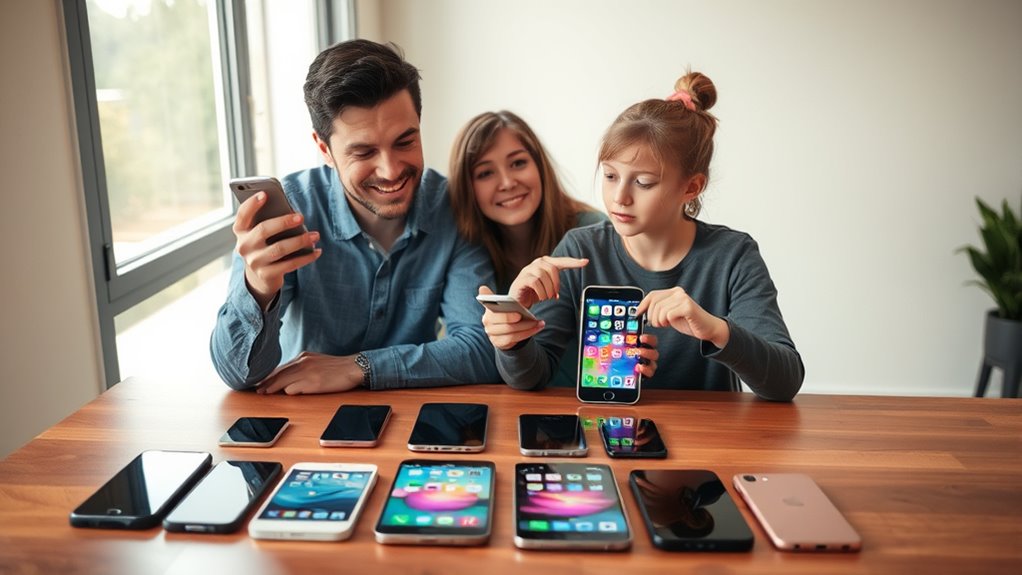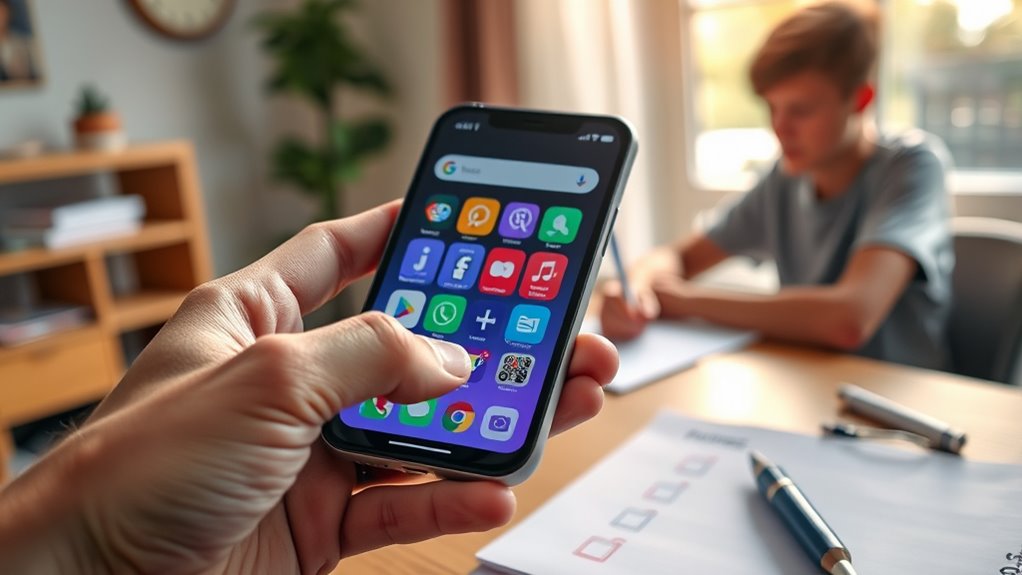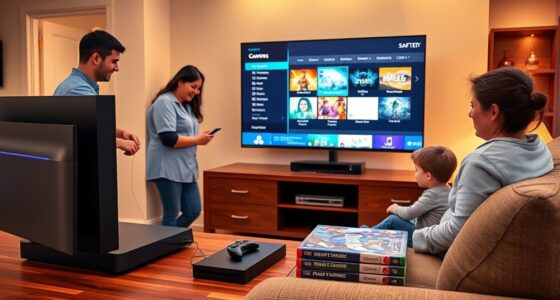When choosing a smartphone for your child or teen, focus on safety features like parental controls, GPS tracking, and content filtering to protect them online. Consider their age and maturity to pick an easy-to-use device or a smartphone with advanced functionalities as they grow. Stay within budget by exploring affordable, durable models with essential features, and look for devices with strong security options. To make the best choice for your family, explore more helpful tips below.
Key Takeaways
- Assess your child’s age and maturity to select age-appropriate features and device complexity.
- Prioritize safety features like parental controls, GPS tracking, and content filters.
- Consider your budget, including device cost, data plans, and ongoing expenses.
- Choose durable devices with protective features suitable for your child’s activity level.
- Opt for devices with essential functions—calling, texting, and security options—aligned with your child’s needs.

Choosing the right smartphone for your child or teen can feel overwhelming with so many options available. With so many devices boasting different features, prices, and safety tools, it’s easy to get lost in the choices. To start, consider safety features and parental controls. Devices like Bark Phone and Pinwheel come equipped with built-in controls that let you monitor contacts, messages, and app usage remotely. Many providers also offer location tracking and content filtering, which are essential for keeping your child safe online. Parental dashboards give you real-time oversight and reporting, so you can stay informed about your child’s device activity. Some platforms even include emergency SOS or panic button functions, adding an extra layer of security.
Next, think about your child’s age and maturity level. Simplified phones like the Nokia 2780 Flip or Gabb Phone are best suited for younger children or those just starting to use technology. These phones focus on basic calling and texting, which reduces distractions and limits exposure to inappropriate content. For teenagers, smartphones become more appropriate, especially if they need access to apps and the internet for school or socializing. Before choosing a device, evaluate your child’s responsibility level and their understanding of digital etiquette. As they grow and demonstrate responsible use, you might consider gradual upgrades to more advanced devices.
Consider your child’s maturity when choosing between basic phones like Nokia 2780 Flip and smartphones for teens.
Budget is another important factor. Entry-level smartphones such as the Google Pixel 8a or Samsung Galaxy A15 5G offer good quality at a lower price, making them great options for families on a budget. Dedicated kids’ phones typically cost between $50 and $300, while flagship models can go over $800. Remember to account for ongoing expenses like data plans, accessories, and insurance. Prepaid or family plans can help you manage costs and keep an eye on usage. Buying used or refurbished devices can also be a smart way to save money, especially for first-time users.
Durability matters, especially for younger children prone to drops and spills. Look for devices with rugged cases, water resistance, and smaller, lightweight designs that are easier for kids to handle. Flip phones and simple form factors tend to be less fragile, with fewer breakable parts. Devices with replaceable components, like removable batteries or screen protectors, can extend their lifespan. High-quality build materials and warranty options are additional considerations to make certain the device withstands daily wear and tear. Additionally, understanding the technology behind the device, such as contrast ratio, can help you choose models that perform well in various lighting conditions.
Finally, assess the features and security. Essential functions include texting, calling, and GPS tracking for safety. Older kids and teens might benefit from educational apps, camera quality, and homework tools. Choose devices with limited app stores or locked-down platforms to minimize exposure to inappropriate content. Customizable privacy and notification settings help manage screen time, while integration with family accounts can streamline coordination. Security features like biometric authentication, regular software updates, and parental control apps protect sensitive data. Teach your child best practices for online safety, such as avoiding suspicious links and not sharing personal information. Reviewing top-rated options like Bark Phone, Gabb Phone 4 Pro, and Pinwheel can help guide your decision, along with popular models like Google Pixel 8a or Samsung Galaxy A15.
Frequently Asked Questions
What Safety Features Should I Look for in a Child’s Smartphone?
When picking a child’s smartphone, look for strong safety features like parental controls to limit screen time, app access, and social media activity. Choose devices that allow you to set rules, monitor messages, and restrict unknown contacts. Features like content filtering, safe browsing, and sleep schedule controls help protect your child from harmful content and promote healthy habits. These tools give you peace of mind and help keep your child safe online.
How Can I Set Usage Limits Effectively?
Setting simple, specific, and steady screen time strategies helps you shape your child’s digital discipline. You can use parental controls, craft clear cut rules, and communicate consistently about limits. By monitoring minutes, maintaining momentum, and modifying measures as your child matures, you establish a balanced boundary. Regularly reviewing rules and reinforcing responsible routines ensures your child learns healthy habits and avoids overuse, fostering a safer, more structured digital environment.
Are There Parental Control Apps Recommended for Teenagers?
You’re looking for parental control apps for teenagers, and several options stand out. Bark alerts you to harmful content in messages and images. Qustodio offers web filtering, call monitoring, and a panic button. Norton Family helps manage screen time and video use. FamiSafe tracks driving habits, while Mobicip allows social media monitoring and custom schedules. Choose an app compatible with your teen’s device, check reviews, and make sure it offers the features you need.
What Budget Should I Allocate for a Child’s First Smartphone?
Think of your budget as a roadmap guiding your choices. For a child’s first smartphone, allocate around $70 to $200, depending on age and needs. For younger kids, simpler models like Motorola or Xiaomi work well. Teenagers might need more advanced phones like Samsung or Google Pixel. Remember to budget for accessories, data plans, and potential repairs — a smart investment keeps them connected and safe without breaking the bank.
How Do I Teach Responsible Smartphone Use?
To teach responsible smartphone use, start by setting clear boundaries and rules, like limiting screen time and avoiding usage during homework or family time. Educate your child about privacy, cyberbullying, and critical thinking when evaluating online content. Model good behavior yourself, and have open conversations about social media’s impact on mental health. Encourage balanced use and make sure they understand the importance of safe, respectful, and responsible technology habits.
Conclusion
Choosing the right smartphone for your child or teen may seem overwhelming, but remember, it’s about finding a device that balances safety, features, and their needs. By setting clear boundaries and staying involved, you can help them enjoy the benefits of technology responsibly. After all, isn’t it worth giving them a tool that keeps them connected and secure while still encouraging healthy habits? With careful choices, you’ll make tech a positive part of their growth.










